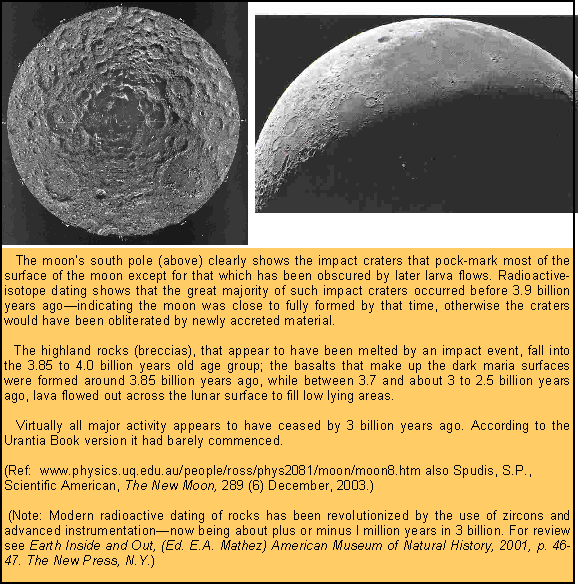|
|
|
|
The Earth-Moon System
There has been some criticism of an article in the July-August issue of Innerface regarding our interpretation of the revelators' use of the words "mass" and "size" in their description of the growth over time of the earth-moon system.
On page 658, the revelators state, "2,500,000,000 years ago the planets had grown immensely in size. Urantia was a well-developed sphere about one tenth its present mass and was still growing rapidly by meteoric accretion."
Then on page-659 they have: "2,000,000,000 years ago the earth began decidedly to gain on the moon. Always had the planet been larger than its satellite, but there was not so much difference in size until about this time, when enormous space bodies were captured by the earth. Urantia was then about one fifth its present size…."
The wording of this last paragraph encourages the belief that these two bodies had grown at the same rate and been much the same size throughout their more than 2 billion year lifetime.
The process of growth by accretion of the earth and its moon satellite while retaining the same growth rate over their first 2 billion years, if it were really true, would indicate that these two bodies utilized the same source materials for their growth as they orbited both one another and the sun together. This conclusion is supported by the announcement (Science, October 12, 2001) that large-scale analysis of rocks and soils from both earth and moon (from the Apollo program) have demonstrated that both are derived from materials having identical oxygen isotope ratios--ratios which vary by large amounts at different spatial locations.
Thus it is difficult to see how, up to the time of the stated capture by planet earth of enormous space bodies 2 billion years ago, this planet and its satellite moon could have had other than similar densities. And if they did that then the revelators' apparently careless use of the terms mass and size becomes explicable, because the relationship, density = mass/volume, means that 2 bodies having the same density and mass must have the same volume or if they have the same density and volume they must also have the same mass.)
However readers should be aware that the slow co-accretion concept for moon and earth, while in favor at the time of receipt of the Urantia Papers, is now known to be quite incompatible with data since accumulated--hence in the category of "proscribed unearned knowledge" (1109), but totally adequate as a "frame in which to think." (1260)
|
|
|
|
|
|
|



